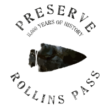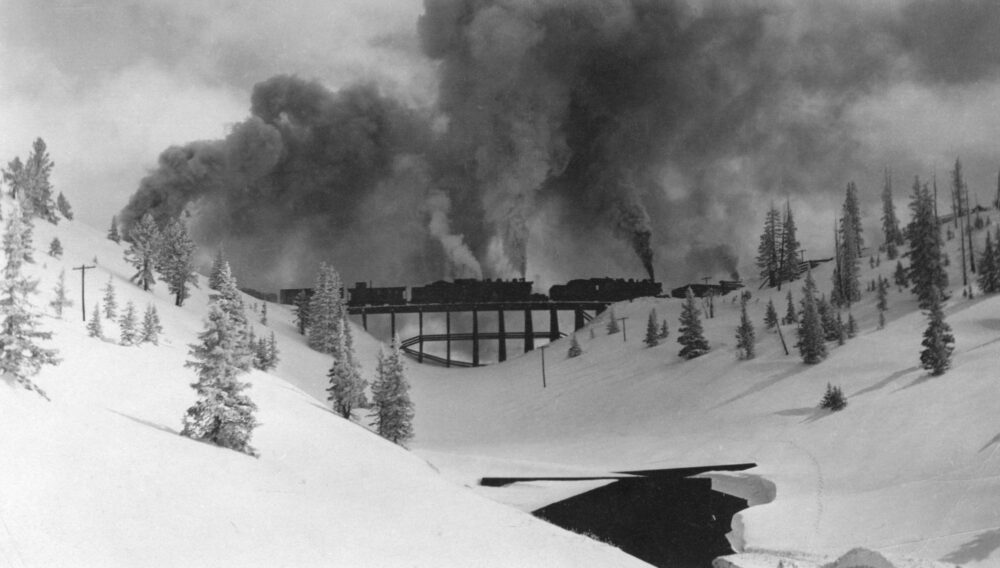Leave No Trace
Leave no trace, don’t pocket the past, and take care of the pass for the future.
This information has been largely repurposed from the Leave No Trace guidance from the National Park Service’s Rocky Mountain National Park page. It has been annotated, expanded, and modified below to assist you in helping preserve Rollins Pass, the Moffat Tunnel areas, the James Peak Wilderness, and the Indian Peaks Wilderness areas. Rollins Pass has no amenities—there are no emergency call boxes, shops, food, vending, restrooms, water fountains, fuel, electric vehicle charging stations, shelter (with the exception of the Årestua Hut on Guinn Mountain), benches, picnic tables, trash receptacles, established campgrounds, pet waste bags/stations, nor AEDs. As such, Leave No Trace guidance that typically mentions metal fire grates, vault toilets, and more has been removed from what is shown below.
With increasing visitor use, both day and overnight, it is important to minimize our impacts and Leave No Trace of our visits to wilderness, parks, and other special places, such as Rollins Pass. Trips that include awareness and the use of minimum impact practices conserve natural conditions of the outdoors which make the adventure enjoyable allows others the same experience.
Leave No Trace is a national program which promotes the protection of our nation’s wildlands through education, research, and partnerships. Leave No Trace teaches minimum impact hiking and camping skills. It also instills wildland ethics and builds awareness, appreciation, and respect for our public recreation places. All federal land management agencies promote the Leave No Trace message. Working with outdoor retailers, educators, and user groups, these federal agencies are making Leave No Trace a common language for all outdoor enthusiasts. For more information, visit the Leave No Trace website.
Leave No Trace is simple, whether you are hiking and camping in the park’s wilderness or driving Rollins Pass for an afternoon. The following seven principles can be applied to any natural setting to minimize human impacts on the environment.
LEAVE NO TRACE
- Plan ahead and prepare
- Travel and camp on durable surfaces
- Dispose of waste properly
- Leave what you find
- Minimize campfire impacts
- Respect wildlife
- Be considerate of other visitors
Please learn and practice Leave No Trace skills and ethics and pass them on to those you come into contact with. It’s easy to enjoy and protect an area simultaneously.
PLAN AHEAD AND PREPARE
- Know and obey the regulations and special guidance for the area you’ll visit. The Rollins Pass Road Status (Corona Pass Road Status) page is an excellent resource for any season and this page is updated weekly, oftentimes daily.
- Be physically and mentally ready for your trip.
- Know the ability of every member of your group.
- Be informed of current weather conditions and other area information. Visit our Frequently Asked Questions page for more information about the area.
- Know and accept risks associated with travelling outside of cell phone range and wilderness experiences. Bring a 406 MHz SARSAT beacon—the peace of mind is well worth the cost. Alternatively, many modern cell phones, such as the latest iPhones, have Satellite SOS capabilities and Starlink is starting to partner with wireless carriers to deploy Direct to Cell capabilities. Learn how these devices and features work from the comfort of your home and before venturing out.
- Take responsibility for yourself and of your group.
- Always leave an itinerary with someone at home. As an extra safety measure: if your vehicle will be parked for a long day or multiple days, consider leaving a small note on your vehicle’s dashboard detailing the number of hikers in your group, ages, experience levels, destination, date/time you plan to return, and emergency contact(s).
- Choose proper equipment and clothing in subdued colors.
- Rollins Pass is no place for flip flops. (Even if you plan to do no hiking, anticipate the need to change a flat tire in cold, windy, and rainy conditions—dress appropriately.)
- Plan your meals and repackage food into reusable containers.
- Bring plenty of fluids and snacks.
- For even more tips, check out our Outdoor Essentials page.
TRAVEL AND CAMP ON DURABLE SURFACES
WHILE TRAVELING:
- Stay on designated trails and hike in single file. Never shortcut switchbacks.
- When hiking cross-country, choose the most durable surfaces available: rock, gravel, dry grasses, or snow. Spread out so you don’t wear a path where one didn’t exist before.
- When you stop to rest, be careful not to mash or crush vegetation. Sit on rocks, stumps, logs, or in clearings.
- When driving, follow our Rollins Pass Route & Driving Tips.
AT CAMP:
- Camp safely away from standing or leaning dead trees.
- Do not camp or build campfires within 100 feet of developed trails or bodies of water, per US Forest Service rules.
- Restrict activities to the area where vegetation is compacted or absent.
- Use a large plastic water container to collect water so you don’t need to make frequent trips to the water source.
- Wash your dishes and yourself at least 200 feet (75 adult paces) from water sources, and use small amounts, if any, of biodegradable soap. Scatter strained dishwater.
- Do not bathe in lakes, ponds, streams, creeks, waterfalls, or rivers.
- Strain food scraps from wash water and pack them out.
- Leave nothing behind, not even food scraps. All food scraps including orange peels, banana peels, or apple cores should be treated as waste. Biodegradation is much slower on Rollins Pass than in a compost heap. Human food, although tasty to us, can be harmful to animals. It can also contribute to habituation—the process where animals get used to human scraps of food along the trails and are drawn to them for that reason—causing potential danger for the people on them.
- Pack everything you bring into the Rollins Pass area as well as the wilderness back out.
- Inspect your campsite for trash and evidence of your stay. Pack out all trash, both yours and others.
DISPOSE OF WASTE PROPERLY
- As there are no pit toilets on Rollins Pass, urinate or defecate at least 200 feet (75 adult paces) from water, camp, or trails.
- Urine contains nitrates that can cause increased algae, making it toxic to fish and other wildlife.
- Urinate in rocky places that won’t be damaged by wildlife who dig for salts and minerals found in urine.
- Carry and use WAG (Waste Alleviating Gel) bags or deposit human waste in cat holes dug 6-8 inches deep. Carry a small garden trowel or lightweight scoop for digging. Cover and disguise the cat hole when finished or pack out solid waste.
- Use toilet paper sparingly and pack it out along with sanitary napkins and tampons in an airtight container. Consider using natural toilet paper such as a smooth rock or soft pinecone.
- Eliminate “micro-trash” by opening candy or energy bars in such a way that any corner pieces are still connected to the main wrapper.
- Pick up any trash you see along the trail—if someone else was mistakenly careless, do nature a big favor and carry it out with you. We all share the responsibility of keeping nature as clean and tidy as possible.
LEAVE WHAT YOU FIND
- Treat our natural heritage with respect—leave plants, rocks, and prehistoric/historical artifacts as you find them. Historic trash isn’t garbage (see video below).
- Good campsites are found, not made. Altering a site should not be necessary. Don’t build structures, break tree branches, or dig trenches.
- Let nature’s sounds prevail. Speak softly and avoid making loud noises, revving engines, or playing music. Allow for others to enjoy the peace and solitude of being in the backcountry or wilderness.
MINIMIZE CAMPFIRE IMPACTS
- Be aware of fire restrictions and/or fire bans in the area. Lead on this issue: others nearby may have been camping for several days or a week outside of cell signal and may not have realized new restrictions were placed into effect. Share the knowledge with the neighboring campsite.
- Some areas near and on Rollins Pass have permanent fire restrictions. Check out our maps page to learn more.
- Campfires can cause lasting impacts to the Rollins Pass area as well as wilderness. Always use a lightweight, portable stove or packable propane grill for cooking. A campfire is luxury, not a necessity, and Colorado has a warm, dry climate, coupled with high winds.
- Enjoy the sounds and wonders of the darkness and starry nights atop Rollins Pass, or use a candle lantern or flickering LED light instead of a fire.
- Where fires are permitted, don’t scar large rocks by using them to enlarge the fire area.
- Gather dead and down sticks no larger than an adult’s wrist from a wide area. Leave them in their natural form until you are ready to burn them. Scatter any unused sticks.
- Do not snap branches off live, dead, or downed trees.
- Put campfires out completely. Drown your campfire with water, stir the embers with wet soil—ensuring all is soaked—then drown everything again. Everything (including the rock fire ring) should be cool to the touch—if it’s too hot to touch, it is too hot to leave.
- Remove and pack out all unburned trash from the ashes of the fire. Scatter the cold ashes over a large area well away from camp.
RESPECT WILDLIFE
- Enjoy wildlife at a distance.
- Never feed wildlife, no matter how cute and friendly they may appear or how closely they approach you. Resist the urge to feed them—even if they beg.
- A carry-in/carry-out bear-resistant food storage canister is recommended for non-wilderness areas and is required April-October for all wilderness sites below treeline.
- If you have an open-top or open-door vehicle, be sure to pack any food or food-related trash with you.
- Don’t pick wildflowers. If it’s tempting, remember: wildflowers start wilting almost immediately once they’ve been picked.
- Minimize noise.
- Avoid sensitive habitat.
BE CONSIDERATE OF OTHER VISITORS
- Visit Rollins Pass areas and the wilderness in small parties—more people means more impact.
- Avoid popular areas during times of high use.
- Have an alternate or backup plan in case trailhead parking lots, campsites, or other areas are full. Do not park on the tundra.
- The presence of tire tracks doesn’t necessarily indicate that an area is open to vehicle use. Set the proper example: follow published and current Motor Vehicle Use Maps (MVUMs).
- Please demonstrate consideration and avoid carving, etching, or spray painting names, dates, symbols, or initials into trees, rocks, or structures.
- Avoid conflicts.
- Minimize noise.
- Keep a low profile.
- Take breaks and rest well off the trail, on a durable surface.
- Yield to horse traffic (horses can spook very easily).
- Respect closed areas and signs.
The primary purpose of our work is to inform the public.

